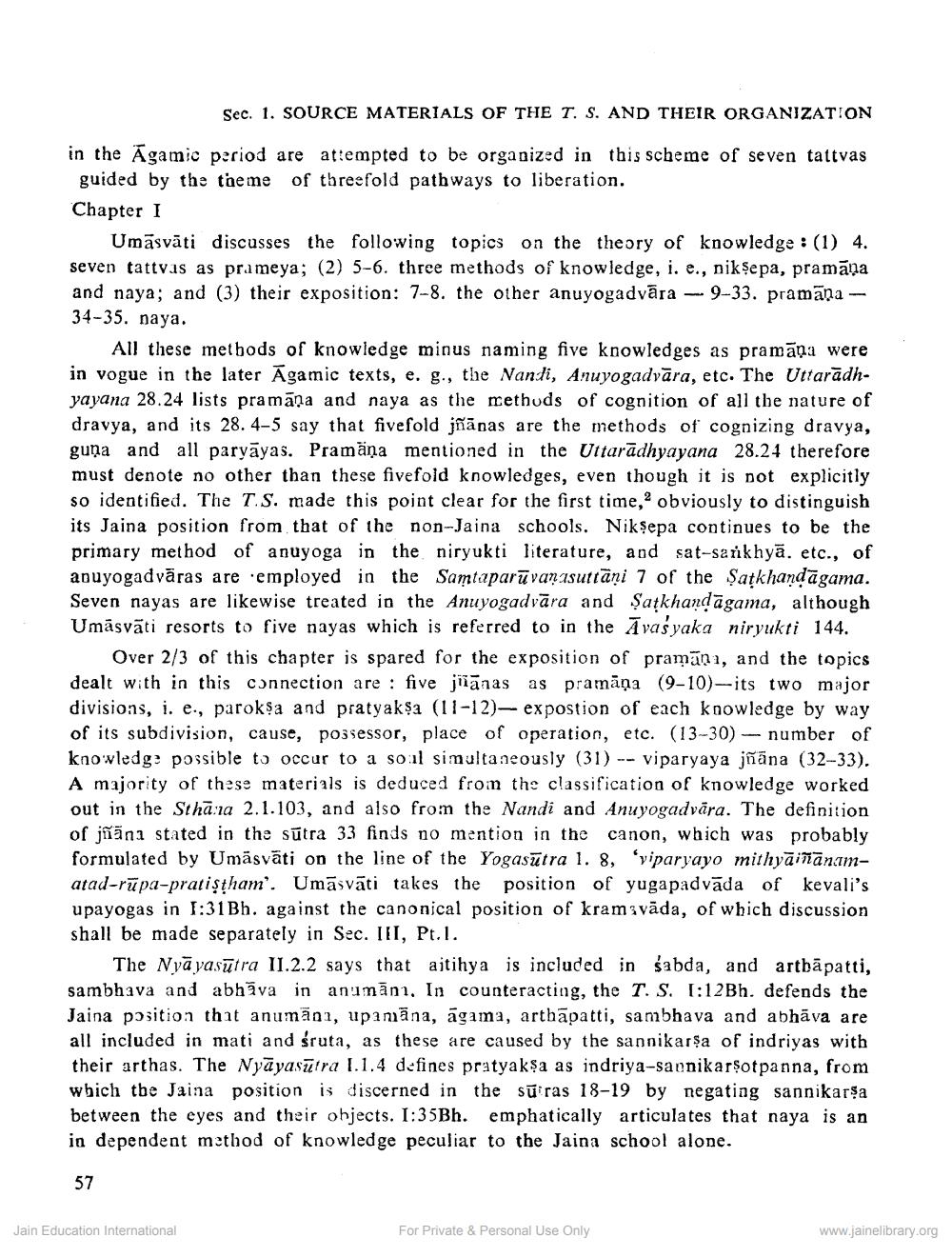________________
Sec. 1. SOURCE MATERIALS OF THE T. S. AND THEIR ORGANIZATION
in the Agamic period are attempted to be organized in this scheme of seven tattvas
guided by the theme of threefold pathways to liberation. Chapter 1
Umāsvāti discusses the following topics on the theory of knowledge : (1) 4. seven tattvas as prameya; (2) 5-6. three methods of knowledge, i. e., niksepa, pramāna and naya; and (3) their exposition: 7-8. the other anuyogadvāra - 9-33. pramāņa - 34-35. naya.
All these methods of knowledge minus naming five knowledges as pramāṇa were in vogue in the later Āgamic texts, e. g., the Nandi, Anuyogadvāra, etc. The Uttarādhyayana 28.24 lists pramāņa and naya as the methods of cognition of all the nature of dravya, and its 28.4-5 say that fivefold jñānas are the methods of cognizing dravya, guņa and all paryāyas. Pramāņa mentioned in the Uttarādhyayana 28.24 therefore must denote no other than these fivefold knowledges, even though it is not explicitly so identified. The T.S. made this point clear for the first time, obviously to distinguish its Jaina position from that of the non-Jaina schools. Niksepa continues to be the primary method of anuyoga in the niryukti literature, and sat-sarkhyā. etc., of apuyogadvāras are employed in the Samtaparūvanasuttāni 7 of the Satkhandāgama. Seven nayas are likewise treated in the Anuyogadvāra and Satkhandāgama, although Umāsvāti resorts to five nayas which is referred to in the Āvas yaka niryukti 144.
Over 2/3 of this chapter is spared for the exposition of pramāna, and the topics dealt with in this connection are : five jiānas as pramāņa (9-10)-its two major divisions, i. e., paroksa and pratyak$a (11-12) - expostion of each koowledge by way of its subdivision, cause, possessor, place of operation, etc. (13--30) - number of knowledge possible to occur to a soal simultaneously (31) -- viparyaya jñāna (32-33). A majority of these materials is deduced from the classification of knowledge worked out in the Sthāra 2.1.103, and also from the Nandi and Anuyogadvära. The definition of jñāna stated in the sūtra 33 finds no mention in the canon, which was probably formulated by Umāsvāti on the line of the Yogasūtra 1.8, ‘yiparyayo mithyāiñānamatad-rūpa-pratiştham'. Umāsvāti takes the position of yugapadvāda of kevali's upayogas in 1:31 Bh. against the canonical position of kramavāda, of which discussion shall be made separately in Sec. III, Pt.l.
The Nyā yasūtra 11.2.2 says that ajtihya is included in sabda, and artbāpatti, sambhava and abhāva in anumāni. In counteracting, the T. S. 1:12Bh. defends the Jaina position that anumāni, upanāna, agama, arthāpatti, sambhava and abhāva are all included in mati and śruta, as these are caused by the sannikarsa of indriyas with their arthas. The Nyāyasūtra 1.1.4 defines pratyaksa as indriya-sannikarsotpanna, from which the Jaina position is discerned in the sūiras 18-19 by negating sannikarsa between the eyes and their objects. I:35Bh. emphatically articulates that naya is an in dependent method of knowledge peculiar to the Jaina school alone.
57
Jain Education International
For Private & Personal Use Only
www.jainelibrary.org




